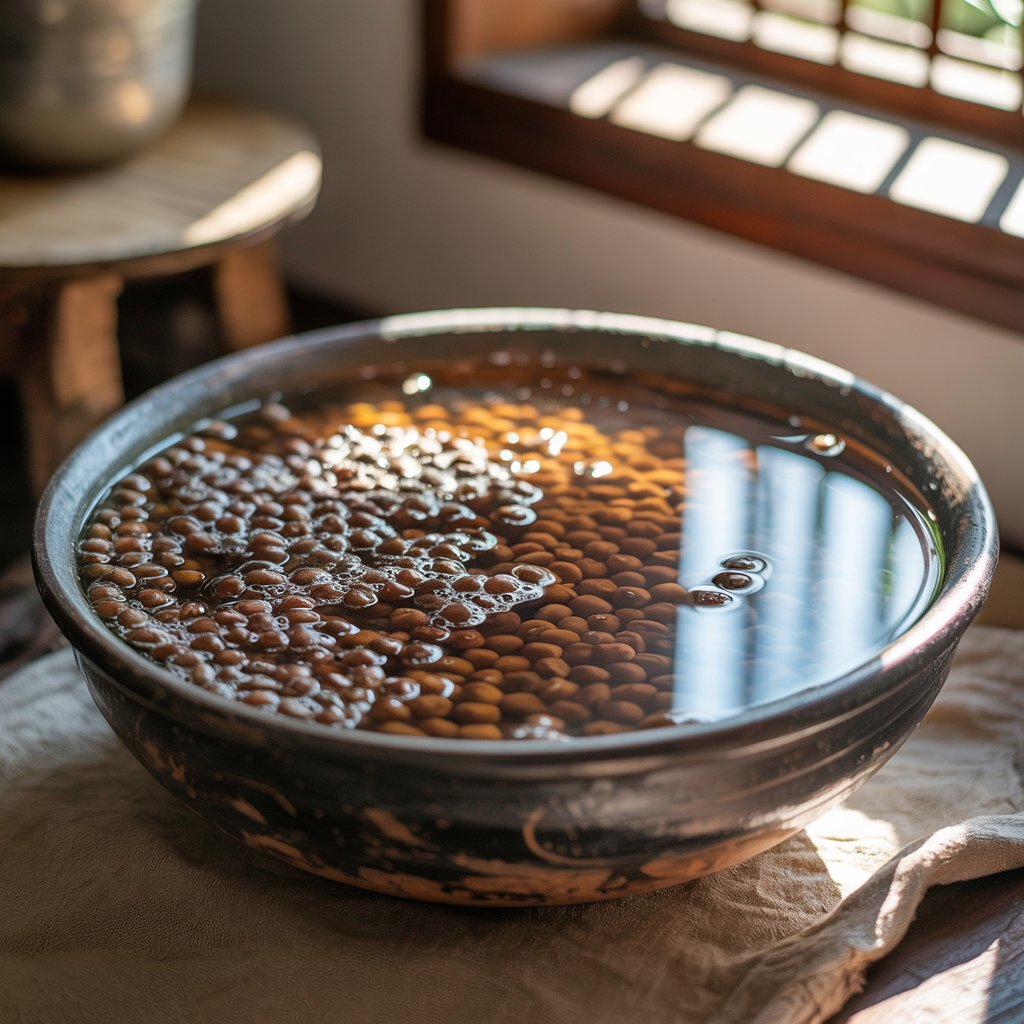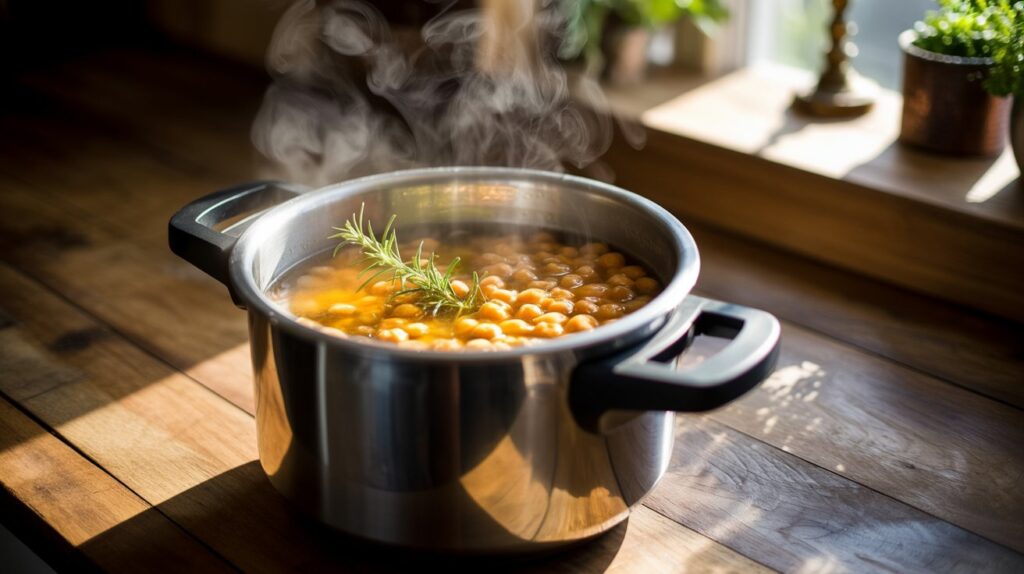Learning the Family Recipe in Nani’s Kitchen

Authentic Tari Wale Chane recipe has been treasured in our family for generations. I still remember the exact sound. First, the sharp crack of cumin seeds hitting hot ghee. Then that unmistakable sizzle that meant Nani was starting her famous Tari Wale Chane. No alarm clock could wake me faster on Sunday mornings than that sound drifting from our tiny kitchen.
Three generations of women passed down this recipe. Each Punjabi woman in our family perfected the technique. Yet we preserved the traditional flavours that make this dish special. Nani never measured anything – she’d grab a handful of garam masala, a pinch of asafoetida (hing), and somehow create magic every single time.

I begged her to teach me this traditional Punjabi chana recipe. She’d laugh and say, “Arre beta, recipes are not in measuring cups. They’re in your hands, your nose, your heart.” But there was one rule she never broke: the black chickpeas had to soak overnight. “Impatience ruins good food,” she’d say, pointing her wooden spoon at me.
The Secret Ingredient: Chickpea Stock
The real secret to making restaurant-style Tari Wale Chane at home wasn’t in any fancy spice blend – it was in something much simpler. She’d save the water from pressure cooking the chickpeas, that cloudy, chickpea-flavored liquid that most people throw away. “This,” she’d say, holding up a ladle of the murky stock, “this is liquid gold. This is what makes restaurant chane taste like home chane.”

The day I got married and moved to my own kitchen, I called Nani in tears. “Nani, I followed everything you taught me, but my homemade black chickpea curry doesn’t taste the same!” She was quiet for a moment, then said, “Beta, did you cook with love or did you cook with worry? Food knows the difference.”
She was right. Once I stopped worrying about getting the perfect Tari Wale Chane recipe and started cooking with the same joy she had – sharing stories, humming old Punjabi songs, thinking about the people I was feeding – the magic happened. The chane started tasting like home.
Now, twenty years later, when I make this easy pressure cooker chickpea curry for my own children, I can almost feel Nani’s presence in the kitchen. Her recipe lives on, not just in the ingredients, but in the way it brings our family together and connects us to our authentic Indian cooking traditions with every single bite.
Nani’s Secret for Authentic Flavour: “The best Indian curry masalas come from whole spices ground fresh. If you want your chane to taste like they do in traditional homes, start with quality whole spices and traditional spice blends – it makes all the difference in achieving that authentic restaurant taste.”

Nani’s Tari Wale Chane Recipe
Cuisine: North Indian4
servings10
minutes30
minutes
Quality Matters: For the most authentic taste, we recommend using our premium ground spices and traditional pickles as accompaniments to complete your meal.
Ingredients
- For Cooking Chane
Black Chickpeas (काला चना) – ½ cup
Onion (प्याज़), roughly chopped – 2 medium pcs
Tomato (टमाटर), roughly chopped – 2 pcs
Garlic (लेहसुन) – 8 cloves
Ginger (अदरक) – 1 to 3 inch
Green Chilli (हरी मिर्च) – 2 pcs
Salt (नमक) – To taste
Black Salt (काला नमक) – ¼ tsp
Turmeric Powder (हल्दी पाउडर) – ¼ tsp
Kashmiri Red Chilli Powder – ½ tsp
Cumin Powder (जीरा पाउडर) – ¼ tsp
Coriander Powder (धनिया पाउडर) – ½ tbsp
Water (पानी) – As required
- For Tempering
Ghee (घी) – 1 tbsp
Asafoetida (हींग) – Pinch
Garam Masala (गरम मसाला) – Pinch
Kasuri Methi Powder – Pinch
Fresh Coriander (हरा धनिया) – Chopped
Directions
- Wash and soak the black chickpeas in water for 6-7 hours at least, or overnight. Nani always said, “Good things take time, beta – let the chane rest and they’ll reward you with the perfect texture.”
- For the prep, add onion, garlic, ginger, and green chilli in a chopper and chop it roughly. You don’t have to make it extremely fine – Nani believed in keeping some texture. Transfer the onion mixture into a bowl and chop the tomatoes similarly.
- Discard the water from soaked chickpeas and add them into a pressure cooker along with the onion mixture and tomatoes.
- Add all the powdered spices and water. Add enough water to make a thin gravy, about 2 inches above the surface of the chickpeas. This is Nani’s secret for the perfect consistency.
- Pressure cook over medium-high flame for 4-5 whistles, then set the flame to low and cook for 10 minutes. Switch off the flame and let the cooker depressurize naturally.
- Once the steam finishes, open the lid and stir well. Check if the chickpeas are cooked properly. If not, cook over low flame for 5-10 more minutes.
- Strain the cooked chickpeas using a strainer. Don’t throw away the stock! You can have it as is – season it with some chaat masala and ghee for a delicious soup.
- Set the same cooker or another stock pot over high flame. Add ghee and let it get hot. This is where the magic happens – the tempering that brings everything together.
- Add asafoetida and the strained boiled chickpeas. Stir well and cook over high flame for 4-5 minutes until the onions and tomatoes become homogenous.
- Add the stock and stir well. You can add hot water to adjust the consistency – it should be thin for this recipe, but adjust according to your preference.
- Let the gravy come to a boil, then let it simmer for 4-5 minutes. The kitchen should smell like heaven by now!
- Taste and adjust the salt if required. Finally, add garam masala, kasuri methi powder, and fresh coriander. Stir well and let the aromas meld together.
- Your home-style, delicious Tari Wale Chane are ready! Serve hot with rotis and steamed rice, just like Nani used to do every Sunday.
Notes
- Perfect Traditional Accompaniments for Tari Wale Chane
Complete your authentic Indian meal with our traditional homemade mango pickle (keri ka achar). The tangy, spicy flavours of these traditional achars perfectly complement the rich, hearty black chickpea curry – exactly how this dish is served in authentic Punjabi homes!
More Authentic Indian Recipes & Cooking Tips
Subscribe to our newsletter for more traditional family recipes, spice guides, and Indian cooking techniques passed down through generations.
Expert Tips for Perfect Tari Wale Chane Every Time
- For restaurant-style richness: Add a dollop of fresh cream or a pat of butter at the end of cooking
- Vegan Tari Wale Chane: Replace ghee with mustard oil for an authentic touch and completely plant-based meal
- Adjusting spice levels: Control heat by adjusting green chilies and red chili powder to your family’s preference
- Storage and reheating: This black chickpea curry tastes even better the next day! Store in refrigerator for up to 3 days
- Pressure cooker vs stovetop: Pressure cooking reduces cooking time by 60% while maintaining authentic flavors
- Serving suggestions: Best enjoyed with fresh roti, naan, or steamed basmati rice

Frequently Asked Questions About Tari Wale Chane
What makes Tari Wale Chane different from regular chickpea curry?
Tari Wale Chane uses black chickpeas (kala chana) instead of regular chickpeas, creating a richer flavor and darker color. The “tari” refers to the thin, flavorful gravy that’s the signature of this authentic Punjabi dish.
Can I make Tari Wale Chane without a pressure cooker?
Yes! You can cook soaked black chickpeas in a heavy-bottomed pot for 45-60 minutes until tender. However, pressure cooking is recommended for authentic texture and to save time.
How long should I soak black chickpeas for best results?
Soak kala chana for at least 6-8 hours or overnight. Proper soaking ensures even cooking and helps achieve the perfect texture that’s characteristic of authentic Tari Wale Chane.
What spices are essential for authentic Tari Wale Chane flavor?
Key spices include garam masala, coriander powder, cumin powder, turmeric, Kashmiri red chili powder, and asafoetida (hing). Fresh ground spices provide the most authentic flavour.
Disclaimer: Recipe results may vary based on equipment and ingredients used. Nutritional information is approximate. This post contains links to our products – individual preferences may vary. Always follow food safety guidelines and ensure ingredients are fully cooked. Consult healthcare providers for dietary concerns.
